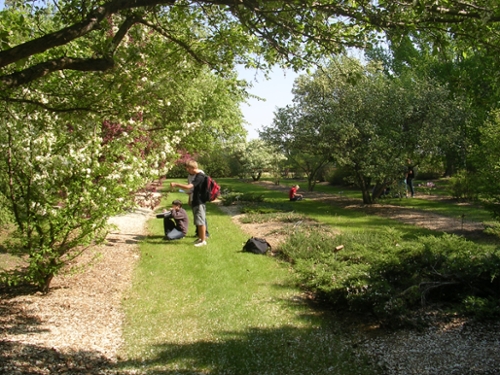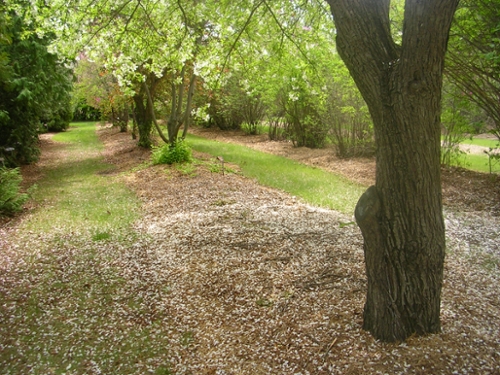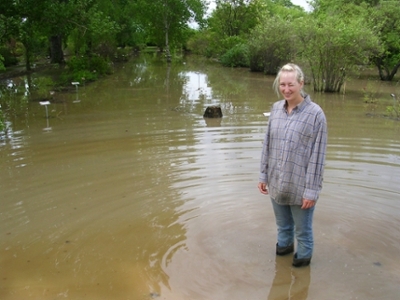Education

The Arboretum is used by many groups and individuals as an outdoor classroom in studies of horticulture and natural science. Plants are labeled with information including common and scientific names, plant family, region of nativity, and date of planting. The facility is a destination for school field trips, horticulture classes, university students, Master Gardeners, arborists, and gardeners.
Botanic gardens and arboreta have an important role in our changing world: the preservation of plant genetic resources in the face of habitat loss, climate change, and the movement of plant diseases and pests. Patterson Garden Arboretum is part of the global network for Botanic Gardens Conservation International an organization that exists to ensure the conservation of plants worldwide.
Tours may be arranged; if you are interested in organizing a tour please contact us.
Prairie Regional Trials for Woody Ornamentals (PRTWO)

Patterson Garden was established as a trial site for the Prairie Regional Trails for Woody Ornamentals (PRTWO) experiment which ran between 1959 and 2001. This experiment into plant hardiness and adaptability was initiated by the Morden Research Station (Morden Research and Development Centre - Agriculture & Agri-Food Canada) in Morden Manitoba. The arboretum at Morden was established early in the history of Prairie horticulture; the experiment involved propagating plants from their collection and distributing them to several sites across the Prairie Provinces to be grown and rated for their survival and adaptability over a five year period. The many trial sites represented a diversity of climatic conditions.
Cooperators in the experiment included:
- Crop Diversification Centre North, Edmonton, AB
- Crop Diversification Centre South, Brooks, AB
- University of Alberta Botanic Garden, Edmonton AB
- School of Forestry, Lakehead University, Thunder Bay, ON
- Lethbridge Research Centre, AAFC, Lethbridge, AB
- Morden Arboretum, AAFC Research Station, Morden, MB
- PFRA Shelterbelt Centre, Indian Head, SK
- Plant Science Department, University of Alberta, Edmonton, AB
- Plant Science Department, University of Manitoba, Winnipeg, AB
- Horticulture Department, University of Saskatchewan, Saskatoon, SK
Experimental results were reported in 2002 by G.C. Davidson, S.M. Enns, and R.J. Enns of the AAFC-Morden Arboretum.
The trial sites today:
Many trees and shrubs from the PRTWO experiment continue to grow at the cooperating research stations and university campuses. Patterson Garden Arboretum and the Devonian Botanic Garden are currently the only PRTWO cooperators that are actively adding woody plants to their collections. The CDC South in Brooks has preserved many of their trees and shrubs by establishing the Golden Prairie Arboretum, Forever Green Pinetum, and Rose Garden.
New Trials and Observations

Several hundred species and cultivars have been tested in the Arboretum since the end of the PRTWO experiment in 2001. Most new additions have been species plants for maximum diversity in our limited space. New acquisitions of native Canadian plants are from wild seed sources whenever possible.
New plants growing well in the Arboretum for the last five years include:
- Manchurian maple (Acer mandshuricum)
- Three-flowered maple (Acer triflorum)
- Devil's walking stick (Aralia spinosa)
- American hornbeam (Carpinus caroliniana)
- Chinese catalpa (Catalpa ovata)
- Buttonbush (Cephalanthus occidentalis)
- Bunge's ash (Fraxinus bungean)
- Fraxinus chinensis subsp. rhynchophylla
- Dyer's Greenweed (Genista tinctoria)
- Kentucky coffee tree (Gymnocladus dioicus)
- Shrubby St. Johnswort (Hypericum prolificum)
- Butternut (Juglans cinerea)
- Manchurian walnut (Juglans mandschurica)
- Prairie crabapple (Malus ioensis)
- Sargent crabapple (Malus sargentii)
- Red mulberry (Morus rubra)
- Korean pine (Pinus koraiensis)
- Chinese red pine (Pinus tabulaeformis)
- Swamp white oak (Quercus bicolor)
- Diamio or Japanese emperor oak (Quercus dentata)
- Rosa maximowicziana
- Apple rose (Rosa villosa)
- Fountain bush (Securinega suffruticosa)
After the Flood...
An unusually wet year, combined with poor site drainage, caused a flood in the Arboretum in 2010. More wet years followed, keeping the soil saturated and the water table high. Mature trees that have died from wet soil conditions include:
- Sugar maple (Acer saccharum)
- Black walnut (Juglans nigra)
- Dahurian larch (Larix gmelini)
- Japanese larch (Larix kaempferi)
- Olga bay larch (Larix olgensis)
- Siberian larch (Larix siberica)
- Amur cork tree (Phellodendron amurense)
- Lavalle cork tree (Phellodendron lavallei)
- Sakhalin cork tree (Phellodendron sachalinense)
- European linden (Tilia cordata)

